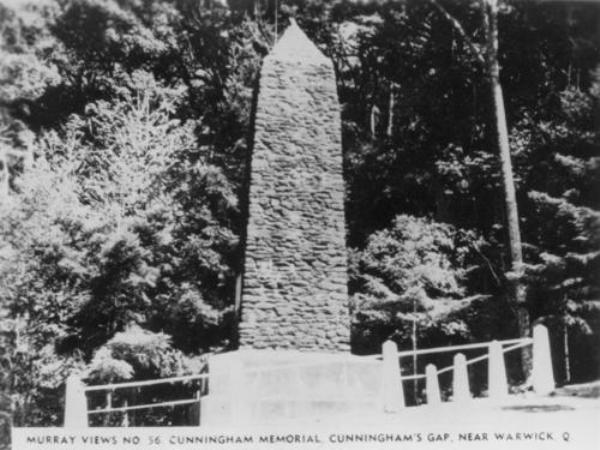By Robert MacMaurice
This June is the 188th anniversary of Allan Cunningham’s journey and discovery of the Darling Downs.
Allan Cunningham’s expedition travelled from Segenhoe Station in the Hunter Valley to the discovery of the Darling Downs and back over a thirteen week period from 30 April 1827 to 28 July 1827. This was a journey of about 1,400 kilometres. He travelled with six men, eleven pack animals and supplies for fourteen weeks. The time he spent in the Southern Downs region can be dated from 5 June 1827 to 6 July 1827. In what follows is a list of places and dates that can be deduced approximately from Allan Cunningham’s journal and report and longitude and latitude recordings and descriptions. Some places he named (not all were adopted), and other names came later.
Herries Range – Tuesday 5 June 1827. It is on this day that Allan Cunningham and his party came out of McIntyre Brook and up onto the Herries Range and saw a most wondrous sight. They looked across the Condamine River and along a beautiful valley with a chain of ponds now called Glengallan Creek.
There had been recent rain and Allan Cunningham noted the extensive pasturage, the richness of the soil and the availability of box and white gums around. It looked like a park. From this vantage point the party travelled through Thane, Greymare and Cunningham. They crossed the Condamine River near Cunningham and kept following Glengallan Creek.
Miller’s Valley (Gladfield and Maryvale area) – Friday 8 June 1827. Two days of rain set in and so after following along Glengallan Creek the party veered over to other points of interest and camped at Freestone Creek. If he had kept following to the upper reaches of Miller’s Valley, he may have discovered Cunningham’s Gap on this expedition. He also named Mount Dumaresq and Mount Sturt and after the rain set out to explore the Swanfels Valley.
Logan’s Vale (Swanfels Valley) – Sunday 10 June 1827. The party camped about ten kilometres up the Swanfels Valley following the Swan Creek.
Sighting Spicer’s Gap – Monday 11 June 1827. Allan Cunningham climbed a ridge that rose to about 1,200 metres on the northern side of the upper Swanfels Valley. From here he observed Spicer’s Gap, Mount Mitchell (which obscured Cunningham’s Gap, about ten kilometres, from where he was standing on the southern side), Mount Warning, Mount Double Top, Flinder’s Peak, amongst other features familiar to him from his 1824 explorations of the Moreton region with John Oxley.
He did not personally examine Spicer’s Gap, because his exertions, to that point, and ongoing suffering from hepatitis had debilitated him. Instead two of his men went to examine the gap, while he waited in camp to recover, and they confirmed the possibility of passage through to the coast.
Killarney – Saturday 16 June 1827. With confirmation of a way to the coast and Brisbane, and realising the need to nurture supplies for the return journey, Allan Cunningham began his southward journey passing slightly west of Killarney. He named this area Canning Downs.
Undercliffe Falls – Monday 25 June 1827. After camping near Undercliffe Falls in the Wylie Creek and Liston area, he continued journeying south, south westerly and noted the strange formations of granite. He crossed the Great Dividing Range and observed creeks flowing east and west. He also observed Bald Rock.
Girraween National Park – Tuesday 26 June 1827. At some point the barriers of granite formations were causing such problems with travel progress, that Allan Cunningham turned backwards and crossed features such as Snakebite Creek, Paling Yard creek, Racecourse Creek, Mount Norman Road, Pyramid Road and McLaughlin Creek.
Eukey, Ballandean – Wednesday 27 June 1827. Once out of the barriers of the granite formations, that so define Girraween, Allan Cunningham again struck a south, south westerly course and passed near Eukey Hall, Doctor’s Creek, Ballandean, and camped at Accommodation Creek.
Upper McIntyre River – Friday 6 July 1827. After leaving his Accommodation Creek camp, Allan Cunningham and his party crossed the Severn River, and then the Upper McIntyre River and began to notice country they had sighted on their northern journey as they approached the Gwydir River.
With this journey Allan Cunningham had discovered one of the richest farming areas in Australia, along with the Spicer’s Gap access to the Downs, from Brisbane. It was a year later on Monday 25 August 1828, that he approached from the Brisbane side and climbed Mount Mitchell, and so observed the western features he had observed a year before, along with Cunningham’s Gap cutting through beside Mount Cordeaux and his vantage point.







